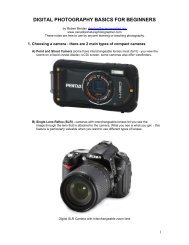Download PDF - The Canadian Nature Photographer
Download PDF - The Canadian Nature Photographer
Download PDF - The Canadian Nature Photographer
You also want an ePaper? Increase the reach of your titles
YUMPU automatically turns print PDFs into web optimized ePapers that Google loves.
MACROPHOTOGRAPHY TOOLS, TIPS & TECHNIQUES FOR DIGITAL PHOTOGRAPHERS 2012<br />
Your menu, if you shoot with a Nikon DSLR should look like those above. To start taking pictures, just<br />
press your shutter button, then rotate the camera and lens slightly by loosening the lens collar and take<br />
9 more shots. When you are done press the preview button to see what your photo looks like. <strong>The</strong><br />
camera will automatically reset back to single shooting mode, so if you want to shoot another series of<br />
multiple exposures, reset the Multiple exposure button and turn it back on. <strong>The</strong> technique is not limited<br />
to rotating the camera, you can simply move the camera up or down as well.<br />
Experiment with 4, 8, 10 or more shots until you get something you like. This technique works well with<br />
flowers or anything colourful. This technique may not be for everyone – but it’s definitely different and<br />
it works with any lens in your camera bag. Check your camera manual if your camera allows multiple<br />
exposures.<br />
Insects & Spiders<br />
<strong>The</strong>re are millions of species of insects and spiders and they are readily available in almost any field or<br />
backyard. Butterflies are probably most people’s favorite because of their showy wings, and they don’t<br />
bite. <strong>The</strong>re are also butterfly conservatories or zoos where folks can visit and photograph a wide variety<br />
of butterflies in an enclosed space. Dragonflies are another favourite subject. Some insects will defend<br />
themselves, so be careful if you trying to photograph one of those species. Try to get as much working<br />
distance as possible e.g., use a 100-200 mm lens. Sometimes you will discover insects and flower<br />
spiders while photographing flowers, such as the flower spider above, photographed with a 60 mm<br />
macro lens and flash.<br />
Robert Berdan | 72




